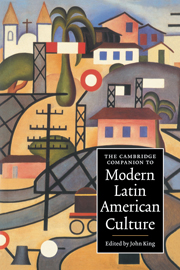Book contents
- Frontmatter
- Introduction
- 1 Pre-Columbian and colonial Latin America
- 2 Latin America since independence
- 3 Spanish American narrative, 1810-1920
- 4 Spanish American narrative, 1920-1970
- 5 Spanish American narrative since 1970
- 6 Brazilian narrative
- 7 Latin American poetry
- 8 Popular culture in Latin America
- 9 Art and architecture in Latin America
- 10 Tradition and transformation in Latin American music
- 11 The theatre space in Latin America
- 12 Cinema in Latin America
- 13 Hispanic USA
- Index
2 - Latin America since independence
Published online by Cambridge University Press: 28 May 2006
- Frontmatter
- Introduction
- 1 Pre-Columbian and colonial Latin America
- 2 Latin America since independence
- 3 Spanish American narrative, 1810-1920
- 4 Spanish American narrative, 1920-1970
- 5 Spanish American narrative since 1970
- 6 Brazilian narrative
- 7 Latin American poetry
- 8 Popular culture in Latin America
- 9 Art and architecture in Latin America
- 10 Tradition and transformation in Latin American music
- 11 The theatre space in Latin America
- 12 Cinema in Latin America
- 13 Hispanic USA
- Index
Summary
Over the last two hundred years there have been continuous debates over the origins, development, identity and future of Latin America. Indeed, this term is itself a Parisian concoction of the 1860s that sought to bestow a terminological unity upon a region that seemed to lack cultural, political, economic and even geographical coherence, particularly to outsiders and especially to Anglo-Americans. Both at home and abroad the quest for a convincing explanation of the evolution of the American ex-colonies of Spain and Portugal has often descended into interpretations based on race or some 'Iberian tradition' or a ubiquitous economic 'dependency'. Whether optimist or fatalist in vision, such essentializing has usually taken on a providentialist spirit and combative tone, but it has rarely matched the assurance of the self-images and ideologies underpinning the popular culture of the United States from the 'manifest destiny' of the 1840s to the globalizing ambition of the post- Cold War era.
As much of the material in this Companion will show, that margin of comparison with ‘the North’ has provided a rich vein of cultural creativity so that even in conditions of economic inferiority and political disadvantage Latin Americans have retained a distinctive identity. By the end of the twentieth century thiswas also true inside the frontiers of the USA itself, where the expansion of the Hispanic population to over 30 million (roughly equivalent to that of Argentina) and the broader effects of globalization had further weakened the over-stressed notion of Anglo-Saxon supremacy, based on the ideology of Protestant supremacism, and the formal egalitarianism of the Founding Fathers, many of whom held slaves.
- Type
- Chapter
- Information
- The Cambridge Companion to Modern Latin American Culture , pp. 28 - 59Publisher: Cambridge University PressPrint publication year: 2004

